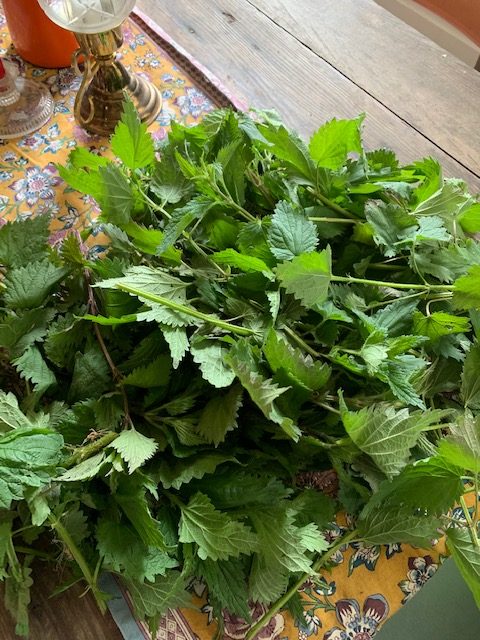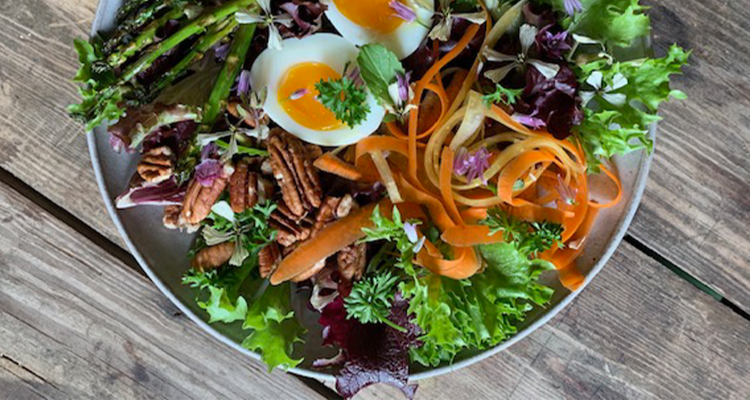Disclaimer: Weelunk cares about your health and safety. Before touching or eating anything out in the wild, we recommend seeking the input of a naturalist or other certified expert. If you have concerns about allergic or other medical reactions to any of the foods listed in this article, you should discuss them with your doctor. Weelunk and its contributors shall not be held directly or indirectly liable for any action that a reader decides to take as a result of this article.
It’s no coincidence that a myriad of greens are the first food to emerge from the ground as winter transitions into spring. We commonly associate winter with comforting, warming and heavier foods. It makes perfect sense that wild and cultivated foods arriving in spring are associated with growth and detoxification.
Spring salads are my love language. There are so many flavors and textures to choose from. From your favorite spot by the river, Wheeling Creek, a hike in the woods or your own backyard, weeds that will enhance your salads in spring are everywhere.

Some wild edibles that make great salad additions in spring are dandelion greens and flowers, chickweed, dead nettle, watercress, miner’s lettuce and violet.
Farmers’ fields are also sprouting the first sweet salad mixes — arugula, spinach, mustard greens, baby kale, chard — at this time. Mixing four or more greens and edible flowers of your finding along with some fresh local herbs (think fennel, tarragon, mint leaves) will make salad more like an adventure and less like a boring head of romaine.
Add a few soft-boiled farm-fresh eggs (the yolks are SO orange in the spring), and you’ve got your protein. Add a fatty, crunchy element to your salad, such as hazelnuts, toasted almonds, spiced pecans, etc., and you’ve likely got your new favorite entree.
Stinging nettles are abundant in spring as well but one touch, and you’ll quickly realize a stinging nettle is NOT a weed to eat raw. Be careful to wear gloves when you pick this weed, which is a member of the mint family.
The stems are rather woody so remove the leaves from the stems and give them a quick rinse. From this point you can dehydrate the leaves or you can cook them up just like spinach. As soon as the leaves wilt in the heat of your sauté pan or pot of water, they will lose their sting. Nettles are great as pesto, on pizza, with potatoes and watercress as a soup, or as a tea. Drinking nettle tea every day may help you deal with seasonal allergies.
Wild and farmed alliums make their first appearance in spring as well. Allium — Latin for garlic — is a genus of flowering plants that includes a multitude of species such as leeks, garlic, onion, scallion, chives and so on. They are praised for their antimicrobial properties.
I’m a fan of the delicious sauces, soups and vinaigrettes to be made with them that accompany spring greens expertly. In the cultivated realm, you’ll see farmers selling spring onions, green garlic (young fresh garlic before mature cloves have formed), garlic scapes, leeks and chives. In nature, you’ll find wild onions and ramps.

I’d say that spring is the best season for locally grown and foraged food, but I’d be lying because I say that every season. Enjoy these fleeting treats before summer rolls in with show-stopping heirloom tomatoes and grilled sweet corn. There is always something exciting to find and to look forward to when you eat with the seasons in the Ohio Valley.
Wild Allium Vinaigrette
You can use the allium of your choice for this recipe. It’s wonderful with ramp bulbs or wild onion bulbs, but you can also use green garlic or even mature cloves of garlic. This vinaigrette is great on a salad of mixed greens or as a marinade for chicken or seafood.
INGREDIENTS:
2 tablespoons ramp bulb, finely minced
Juice of 1 lemon
6 tablespoons honey (maple or agave syrup are great as well)
1 tablespoon stone ground mustard
¼ cup apple cider vinegar
1 cup olive oil
Salt
Pepper
DIRECTIONS:
In a medium bowl, mix minced ramp (or allium of your choice), lemon juice, honey, mustard and vinegar. Whisk well to combine.
Slowly begin pouring the olive oil in while continuing to whisk to emulsify the olive oil and the vinegar. Add salt and pepper to taste.
• Melissa Rebholz was born and raised in Buffalo, New York, to a Sicilian/German family. She grew up in a household revolving around food. In 2007, a summer of volunteering for GrowNYC (New York City’s Farmer’s Markets) led her down the path to culinary school at The Natural Gourmet Institute and 10 subsequent years of farming from Long Island to Sonoma to Tennessee. Working simultaneously in kitchens to support her farming habit, Melissa migrated back to the rustbelt in October of 2019 to help Grow Ohio Valley open the Public Market as the head chef. Her hobbies include foraging, baking, dinner parties and exploring her new home of Wheeling, West Virginia.


